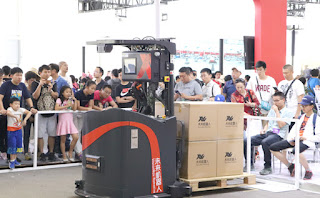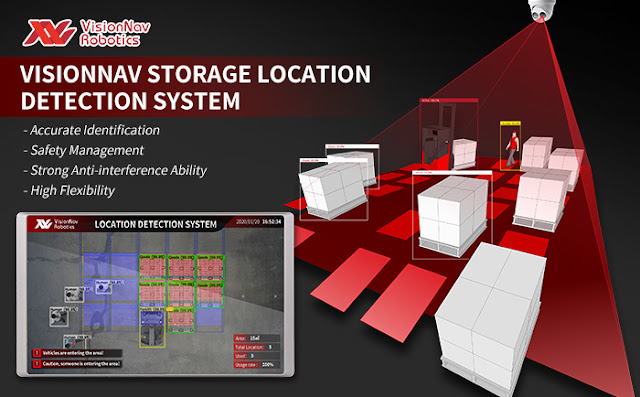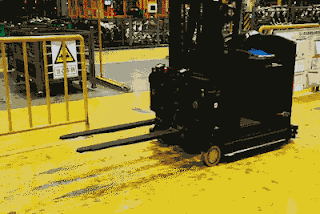Sinotrans "Smart Logistics" Delegation Visited VisionNav Robotics to Accelerate
Corporation for New Projects
On September 5, 2019, Sinotrans "Smart Logistics" team visited
VisionNav Robotics. They had detail technical communications with Dr. Li Luyang,
CEO of VisionNav Robotics, about the upcoming automated warehousing project. Mr.
Mo Haiyang, Assistant General Manager of VisionNav Robotics, also introduced their
unmanned warehouse and latest technological achievements. In addition, both
parties discussed in-depth on topics such as smart logistics, advantages and
disadvantages of warehouse robots, project implementation experience, and so
on.
 |
| Li Luyang introducing unmanned transportation roadmap to Sinotrans team |
Sinotrans Smart Logistics
Embraces New Changes as Logistics Giants Are All in transition
As China pursuing supply-side
reform, and recent breakthrough and application of artificial intelligence, big
data, LOT and 5G technology, all levels of the society have undergone profound
changes, therefore the development of logistics industry is also facing an
important inflection point. With the rapid development of cross-border
logistics, e-commerce and mega-cities, large numbers of 3rd party
logistics, industrial logistics and ecommerce logistics start to focus on
warehousing logistics, creating a new pattern for logistics industry.
- In 2014, JD.com started to build Asia No.1.
- In 2016 May, JD-X established.
- In 2017 May, Cainiao Network proposed to set up Smart Logistics Park in Yuhang
- In 2018 February, the Central Bureau of Beijing Post Area released intelligent transportation robot project for testing in public.
- In 2018 March, SF Express obtained the pilot license of drone operation.
- In 2018 Deppon Express planed to invest AGVs in its distribution center in Pudong on a trail basis.
- ……
As CMG’s unified logistics
operation platform and brand, since its third strategic transformation,
Sinotrans has always taken the goal of “building a world-class smart logistics
platform enterprise” as its development goal. With the help of total
digitalization, it completes the transformation of logistics providers and
integrators to logistics platform providers by comprehensively reconstructing
its operation, business and organization models. And the first step of such
transformation is to reduce labor and increase logistics value and efficiency with
mechanized, automated, unmanned equipment, as well as informationalized,
digitized, intelligentized applications.
TOP10 Chinese Logistics Enterprises
2016 Ranking
|
2018 Ranking
|
||
Rank
|
Enterprise
|
Rank
|
Enterprise
|
1
|
Sinotrans
|
1
|
Sinotrans
|
2
|
Cosco Shipping Logistics
|
2
|
Cosco Shipping Logistics
|
3
|
SF Express
|
3
|
SF Express
|
4
|
CNPC Transportation
|
4
|
CNPC Transportation
|
5
|
Yuan Cheng
Logistics
|
5
|
Yuan Cheng
Logistics
|
6
|
Deppon Logistics
|
6
|
YTO Express
|
7
|
Fujian
Provincial Communication Transportation
|
7
|
Deppon Logistics
|
8
|
YTO Express
|
8
|
JD.com Logistics)
|
9
|
JCtrans
Logistics Group
|
9
|
JCtrans
Logistics Group
|
10
|
Jizhong Energy Group
International Logistics
|
10
|
Jizhong Energy Group
International Logistics
|
Data sources: CCTA
Figure: The key of Sinotrans' "build to last" strategy is timely
industry transform.
"The reason why we only work on
unmanned forklifts and persist in this field for three years," Li Luyang
introduced, is because VisionNav Robotics team knows that the landing of any
material handling robots requires the support of massive data, including
technical and industry recognition ability from a large number of scenarios. "We hope that being integrated can help to land scenarios faster, and we
complete product iterative upgrade through digitalization." This is just align
with the concept of digitalization proposed in smart logistics 3.0 by
Sinotrans. VisionNav Robotics is willing to deepen "Smart Logistics" with
Sinotrans to achieve greater cost reduction and increasing efficiency.
Material
Handling Robots Seamlessly Apply in Modern Logistics? Peak Efficiency vs. Absolute
Efficiency
In the field of logistics, the
construction of warehousing platform is crucial to logistics costs. By the end
of 2017, the area of commercial (room temperature) warehouses in China reached
1.038 billion square meters, 4% increase from a year earlier. Among them, stereoscopic
warehouses accounted for 26.4%, single warehouses for 58%, and multistoried
storehouses for 15.6%.
After a round of
"enclosure" expansion, warehouse automation has become a basic
requirement of modern logistics. AGV (automatic guided vehicle), automated shelving,
picking robot, automatic identification, automatic sorting and other related
devices have become standard configuration in a warehouse. However, unless
there is further breakthrough in visual identification, artificial intelligence
and LOT, the efficiency of robot operations is still lower than human
operation. It is true that storage automation has made great process in informatization,
but transferring and storage is still the short board. The huge difference
between input and output discourage many enterprises to use material handling
robots.
"Although robots cannot reach
the same peak efficiency as human, they have always maintained its peak
efficiency." Luyang Li said. To seamlessly integrate material handling
robots into the modern logistics industry requires process optimization, which
can reduce the occurrence of bursting problems that affect robot operation.
Technology
Landing Requires the Focus on End-User Requirement and Scenario Analysis in
Depth
"We have a lot in
common", Mr. Gao, Head of Logistics Automation Contractor at Sinotrans
South China headquarter, said with emotion during the discussion about project
landing plan,. Sinotrans's upcoming automated warehousing project covers more
than 20,000 square meters. It will be mainly used to serve industrial supply
chain warehousing and logistics business. The plan is to use automated
warehousing facilities covering the entire production line. VisionNav robot
unmanned forklifts will act as "blood" circulation inside the
warehouse. And it will also be a challenge for VisionNav Robotics to stack
cages up to 9 meters. It will be the first application in the industry as well.
"Our
interaction with customers is more like 'answering questions'. Because there
are diverse scenarios in AGV downstream industry, it is very difficult to use a
fixed product to meet actual requirement of different customer. We don’t
produce forklift vehicle, instead we put more technical resources to better
solve problems for our customers". So far, VisionNav Robotics can provide
unmanned upgrade transformation to forklift from different brands, including
main products from Linde, Nichiyu, Crown, Hangcha, Heli, Rebot, etc. With
accumulated project experience in different scenarios, VisionNav Robotics has
already realized multiple applications of warehousing logistics and production
logistics with different technologies,
for example material transfer between production lines, from production line to
warehouse, storage into high level, multi-layer stacking, etc.
Mr. Mo Haiyang
also invited the delegation to visit VisionNav Robotics’ unmanned warehouse to
understand our newly-developed multilayer cages stacking application. With a
deep understanding of user scenarios, spatial perception and safety protection
capability have been enhanced based on previous project experience. Forklift
AGV now can stack and place cages very precisely for high-level position. Such
breakthrough will help VisionNav Robotics further expand their application in a
larger scope and depth.
 |
| Forklift AGVs for multilayer cages stacking |
 |
| Mo Haiyang introducing their perception technology on the forklift AGV |
Sinotrans delegates
asked about unmanned forklift spatial perception and navigation technology, and
expressed their affirmation of the stability and technical level of VisionNav Robotics
unmanned forklift. In the end, both parties expressed strong expectations for
the cooperation of project establishment. In the field of smart logistics, both
parties can communicate in depth, empower each other, and achieve cost
reduction during highly efficient operations.
End.





































